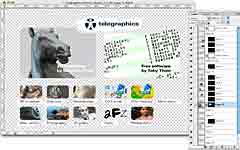Last update : March 21, 2016

Favicons plugin by Telegraphics
Favicons (.ico files) are the little pictures at the left of the URL on the address bar of the browser. Favicons are an excellent free branding tool for webmasters and blog owners. They help you create brand awareness. Favicons are downloaded by each new visitor to a website. Favicons are extremely important because they are requested before any other components by the browser. By optimizing faveicons, you reduce bandwidth costs and server load.
With the code
<link rel="shortcut icon" href="chateau.ico" />you can reference any location for the favicon. If it is absent, the Browser tries to fetch it from the domains root instead and each time the browser requests this file, the cookies for the server’s root are sent.
![]() An outstanding tutorial how to include favicons on websites and especially in WordPress blogs is shown at MaxBlogPress. There are various free tools available to create favicons. A plugin for Photoshop to create and optimize favicons is available from Telegraphics, free software by Toby Tain.
An outstanding tutorial how to include favicons on websites and especially in WordPress blogs is shown at MaxBlogPress. There are various free tools available to create favicons. A plugin for Photoshop to create and optimize favicons is available from Telegraphics, free software by Toby Tain.
Thera are also numerous online webtools available to create and optimize favicons, for example :
- Real Favicon Generator, by Philippe Bernard
- Favic-O-Matic, by Esacor S.R.L
- Favicons from Pics by HTLM-Kit
- X-Icon Editor by Avarice S.r.l
- favicon.cc by Xoron GmbH
Some useful links to websites with more information about optimizing favicons are listed below :
- Favicon.ico Compression Tutorial, by Sam Allen
- Best Practices And Tools For Optimizing Images, by Akmal Wardak
